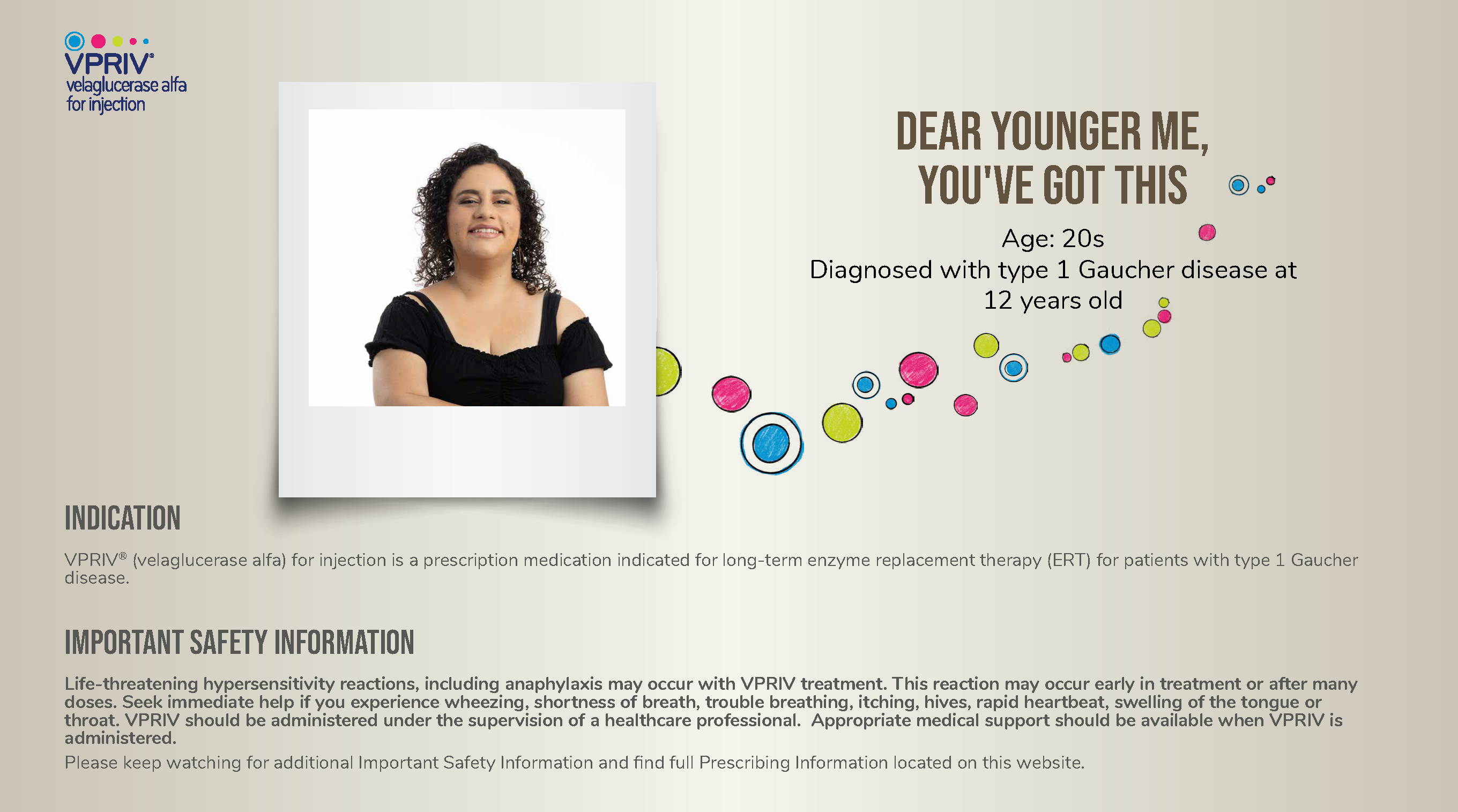laura’s story
AGE: 20s
Age at Diagnosis: 12
Location: Puerto Rico
Laura’s story is a testament to hope and perseverance. Growing up with type 1 Gaucher disease (GD1) was challenging, not least because she rarely met others who shared her experience. However, she finds joy in connecting with younger patients now, offering them the wisdom and support she wished she had received.


Challenges of Childhood
“For a long time, my teachers did not understand me or what I was going through, and I had to deal with a lot of bullying. It was difficult to run, jump, skip, or keep up with the other kids.”
From a young age, Laura faced numerous health struggles. At just four years old, she contracted dengue fever, which was initially misdiagnosed as Epstein–Barr virus. However, her mother later noticed other symptoms and suspected something more was at play. Following recommendations from family, she was taken to specialists, eventually being diagnosed with splenomegaly and thrombocytopenia. Two years later, at the age of seven, she received another diagnosis—rheumatoid arthritis. Despite visits to hematologists and rheumatologists, her condition remained a mystery, with doctors offering diagnoses they were familiar with, but none that fully explained her symptoms.
Laura’s childhood was filled with countless medical tests, from MRIs to bone marrow biopsies. For years, doctors suspected conditions like lupus or cancer, but nothing seemed to fit. Throughout this uncertain time, Laura struggled not only with her health but also with social challenges. Frequent hospital visits meant missing school, which led to misunderstandings with teachers and bullying from classmates. Her swollen left side, a result of her enlarged spleen, made her a target, and she often felt isolated.
Finding Support in Facing Diagnosis
“My mom…helped me manage my new diagnosis. She sat me down one night in the living room and said: ‘This is what you have to deal with. But just so you know, you’re not alone. You have me and your father, and that’s all that matters.”
At age 12, after a particularly difficult period involving severe knee inflammation, her rheumatologist consulted a geneticist. This crucial step finally led to the correct diagnosis: GD1.
While receiving the diagnosis was a relief, it also brought new worries and challenges. Living in Puerto Rico, accessing treatment was not straightforward, and it took a year to find the right hospital. At one point, her family even considered relocating to improve her access to care.
watch Love, Me Video

Laura’s mother played a vital role in helping her come to terms with the diagnosis. Sitting her down one night, she reassured Laura that she was not alone, reminding her that their family would face this challenge together. A children’s book titled ‘David Explores Gaucher Disease’ also helped Laura understand her condition in a relatable way.

Starting Treatment and Adjusting to Life
“The advice I have for those about to start infusion is not to be scared of change. To give yourself a try … You will discover a lot about yourself you didn’t know before.”
After thorough discussions with her family and doctors, carefully considering the risks and benefits of the available treatment options, a decision was made for Laura to begin enzyme replacement therapy with VPRIV. Her doctors explained that VPRIV is intended for the long-term treatment of GD1 and provided detailed information about its potential side effects.
Every patient’s treatment experience will be different. Her progress was closely monitored by her doctors, and they were pleased with improvements in her hemoglobin levels, platelet counts, and spleen size. Treatment days became a part of her routine, starting early in the morning and involving hospital visits, infusions, and check-ins with her doctors. While she doesn’t always feel like going, Laura values the relationships she’s built with her healthcare team, seeing them as an extended family.
Growing and Looking Forward
“I want to become a community social worker. I want to continue with my activism in my community and all over Puerto Rico. I want to continue treatment and continue sharing my story outside of Puerto Rico.”
Laura’s experience with managing her GD1 hasn’t been without challenges, and some are unavoidable. When Hurricane Maria brought devastation to Puerto Rico, it cut power to the hospitals, resulting causing delay to her treatment. Thankfully, though, such disruptions rare and Laura remains committed to maintaining her consistent treatment plan.
Today, Laura is a university student majoring in social work, an active community leader, and an advocate for others living with Gaucher disease. She is especially passionate about sharing the struggles she’s faced as a woman from the small-town community Barrio Obrero Marine and how that impacts her life with GD1 and her access to treatment. She finds fulfillment in sharing her story as a VPRIV ambassador, building connections, and helping stop others from feeling alone.

Reflecting on her journey, Laura emphasizes the importance of support systems, managing energy levels, and seeking spiritual grounding. She encourages others with Gaucher disease to seek out communities that understand their experiences and to take things step by step.
If there’s one word that encapsulates Laura’s journey, it’s resilience. She has faced numerous challenges, but her determination to live life to the fullest remains unwavering. Her story serves as an inspiration to others, proving that with the right support, management, and mindset, life with Gaucher disease can still be meaningful and fulfilling.
 Back to Intro Page
Back to Intro Page




